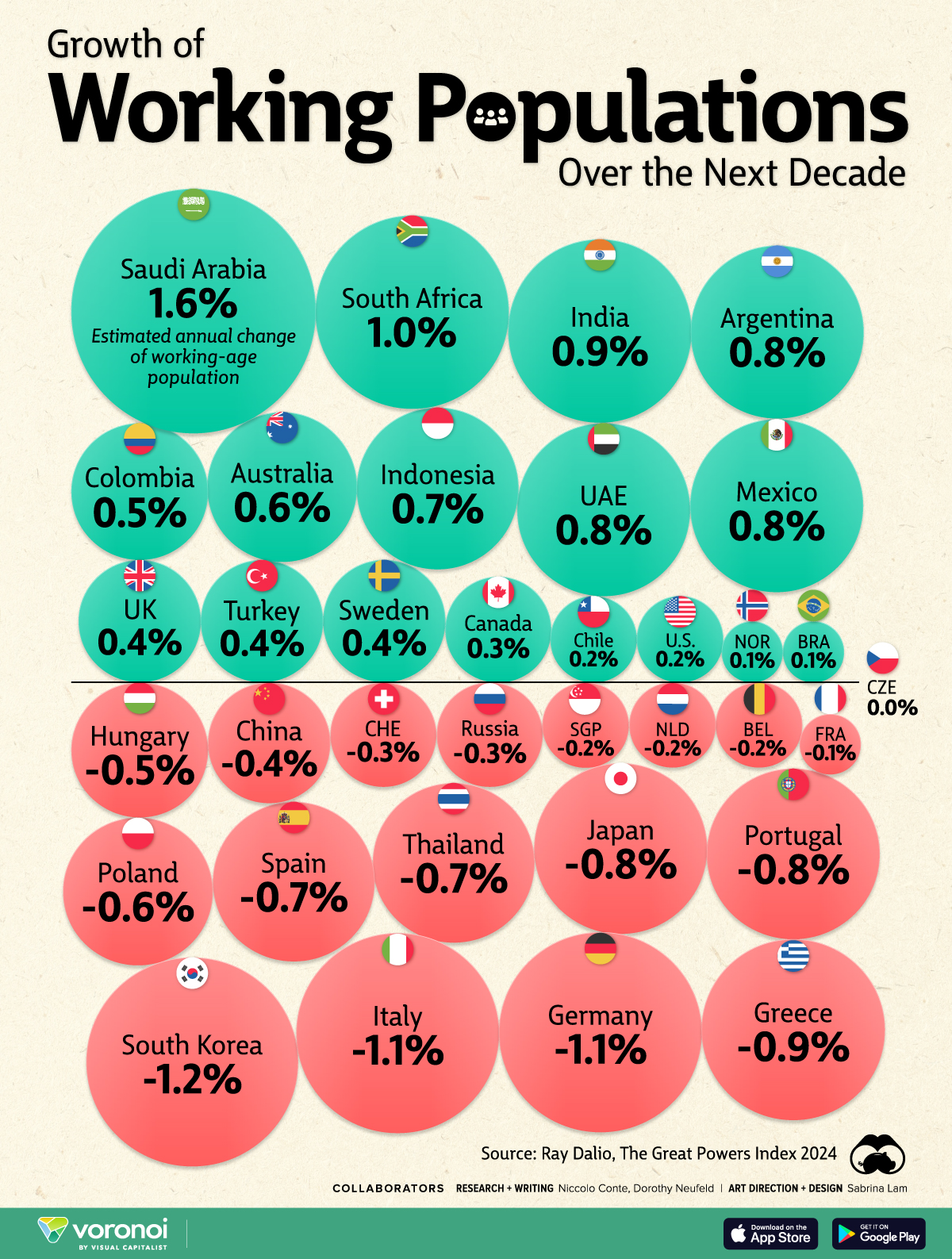Dorothy Neufeld
2024-09-23 11:23:14
www.visualcapitalist.com
The Growth in Working Age Populations Over 10 Years
This was originally posted on our Voronoi app. Download the app for free on iOS or Android and discover incredible data-driven charts from a variety of trusted sources.
Today, the working age population in almost half of U.S. metropolitan areas has declined due to demographic shifts, and this trend is set to continue.
As a result, the U.S. workforce is projected to grow at just 0.2% annually over the next decade, roughly a quarter of the rate of markets like India and Mexico. Given the low birth rates and aging populations across many advanced economies, the world’s workforce is set to change significantly, with implications for economic and productivity growth.
This graphic shows the projected growth in major economies’ working age population, based on analysis from Ray Dalio’s Great Powers Index 2024.
An Evolving Global Workforce
Here are the estimated annual changes in the working age population across 35 countries over the next decade:
| Rank | Country | 10-Year Estimated Annual Change in Working Age Population |
|---|---|---|
| 1 |  Saudi Arabia Saudi Arabia |
1.6% |
| 2 |  South Africa South Africa |
1.0% |
| 3 |  India India |
0.9% |
| 4 |  Argentina Argentina |
0.8% |
| 5 |  Mexico Mexico |
0.8% |
| 6 |  UAE UAE |
0.8% |
| 7 |  Indonesia Indonesia |
0.7% |
| 8 |  Australia Australia |
0.6% |
| 9 |  Colombia Colombia |
0.5% |
| 10 |  UK UK |
0.4% |
| 11 |  Turkey Turkey |
0.4% |
| 12 |  Sweden Sweden |
0.4% |
| 13 |  Canada Canada |
0.3% |
| 14 |  Chile Chile |
0.2% |
| 15 |  United States United States |
0.2% |
| 16 |  Norway Norway |
0.1% |
| 17 |  Brazil Brazil |
0.1% |
| 18 |  Czech Republic Czech Republic |
0.0% |
| 19 |  France France |
-0.1% |
| 20 |  Belgium Belgium |
-0.2% |
| 21 |  Netherlands Netherlands |
-0.2% |
| 22 |  Singapore Singapore |
-0.2% |
| 23 |  Russia Russia |
-0.3% |
| 24 |  Switzerland Switzerland |
-0.3% |
| 25 |  China China |
-0.4% |
| 26 |  Hungary Hungary |
-0.5% |
| 27 |  Poland Poland |
-0.6% |
| 28 |  Spain Spain |
-0.7% |
| 29 |  Thailand Thailand |
-0.7% |
| 30 |  Japan Japan |
-0.8% |
| 31 |  Portugal Portugal |
-0.8% |
| 32 |  Greece Greece |
-0.9% |
| 33 |  Germany Germany |
-1.1% |
| 34 |  Italy Italy |
-1.1% |
| 35 |  South Korea South Korea |
-1.2% |
Saudi Arabia is projected to see the fastest-growing workforce across major economies, driven by high fertility rates of 2.8 children per woman and a rising expatriate population.
India, ranking in third, is set to contribute 24.3% of the world’s workforce over the next decade. With a current median age of 28.4, its working age population is expected to surpass one billion by 2030. These factors provide a significant competitive edge, especially in the services and manufacturing sectors, while also driving increased consumption among younger generations in the world’s most populous country.
Largely due to falling birth rates, the U.S. ranks 15th overall in the 35 countries on the list. In fact, America saw the slowest decade of population growth between 2010 and 2020 since the Great Depression, growing by 7.4%. For perspective, the U.S. population grew at nearly double this rate during the 1990s.
At the other end of the spectrum, South Korea ranks in last, with its workforce projected to see an annualized growth rate of -1.2% over the next 10 years. South Korea has the lowest fertility rate worldwide along with restrictive immigration policies, which are straining working age population growth and productivity.
Overall, 49% of major economies are projected to see declining working age populations, particularly across European nations and countries in Asia including China, Japan, and Thailand.
Learn More on the Voronoi App 
To learn more about this topic from an asset class perspective, check out this graphic on 10-year asset class return forecasts.
The post Visualizing the Growth in Working Age Populations Over 10 Years appeared first on Visual Capitalist.
Support Techcratic
If you find value in Techcratic’s insights and articles, consider supporting us with Bitcoin. Your support helps me, as a solo operator, continue delivering high-quality content while managing all the technical aspects, from server maintenance to blog writing, future updates, and improvements. Support Innovation! Thank you.
Bitcoin Address:
bc1qlszw7elx2qahjwvaryh0tkgg8y68enw30gpvge
Please verify this address before sending funds.
Bitcoin QR Code
Simply scan the QR code below to support Techcratic.

Please read the Privacy and Security Disclaimer on how Techcratic handles your support.
Disclaimer: As an Amazon Associate, Techcratic may earn from qualifying purchases.






























![Pioneer [Blu-ray]](https://techcratic.com/wp-content/uploads/2024/11/81EmJG9mivL._SL1500_-360x180.jpg)





















![Matekxy for Tesla Model Y/3 Center Console Organizer Tray, [Perfectly Tidy] [Built-in…](https://techcratic.com/wp-content/uploads/2024/11/71gbH-x8cSL._AC_SL1500_-360x180.jpg)




![Alien Stickers [200pcs] UFO Stickers for Teen, Vinyl Water Bottles Waterproof Stickers for Laptop Guitar Scrapbook Skateboard Stickers](https://techcratic.com/wp-content/uploads/2024/11/91DUuGusXeL._AC_SL1500_-360x180.jpg)











